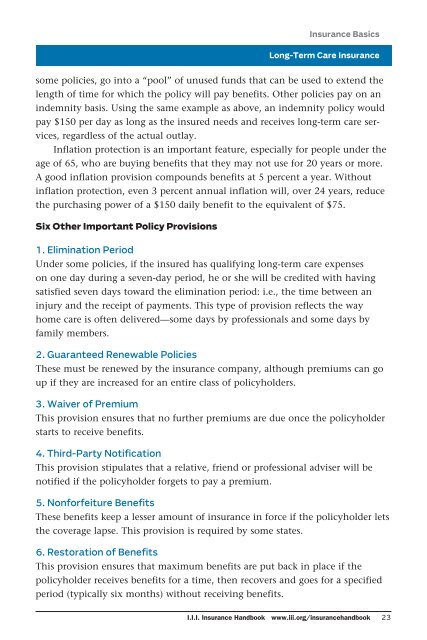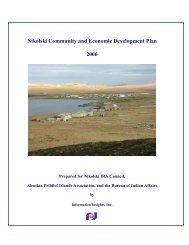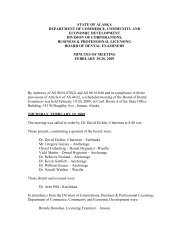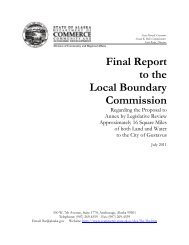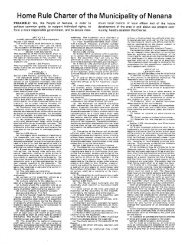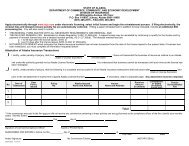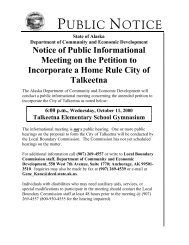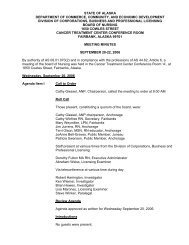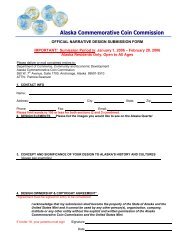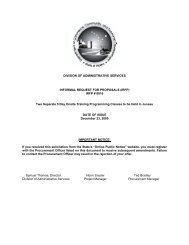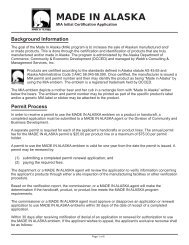Insurance Handbook - Alaska Department of Community and ...
Insurance Handbook - Alaska Department of Community and ...
Insurance Handbook - Alaska Department of Community and ...
Create successful ePaper yourself
Turn your PDF publications into a flip-book with our unique Google optimized e-Paper software.
some policies, go into a “pool” <strong>of</strong> unused funds that can be used to extend the<br />
length <strong>of</strong> time for which the policy will pay benefits. Other policies pay on an<br />
indemnity basis. Using the same example as above, an indemnity policy would<br />
pay $150 per day as long as the insured needs <strong>and</strong> receives long-term care services,<br />
regardless <strong>of</strong> the actual outlay.<br />
Inflation protection is an important feature, especially for people under the<br />
age <strong>of</strong> 65, who are buying benefits that they may not use for 20 years or more.<br />
A good inflation provision compounds benefits at 5 percent a year. Without<br />
inflation protection, even 3 percent annual inflation will, over 24 years, reduce<br />
the purchasing power <strong>of</strong> a $150 daily benefit to the equivalent <strong>of</strong> $75.<br />
Six Other Important Policy Provisions<br />
<strong>Insurance</strong> Basics<br />
Long-Term Care <strong>Insurance</strong><br />
1. Elimination Period<br />
Under some policies, if the insured has qualifying long-term care expenses<br />
on one day during a seven-day period, he or she will be credited with having<br />
satisfied seven days toward the elimination period: i.e., the time between an<br />
injury <strong>and</strong> the receipt <strong>of</strong> payments. This type <strong>of</strong> provision reflects the way<br />
home care is <strong>of</strong>ten delivered—some days by pr<strong>of</strong>essionals <strong>and</strong> some days by<br />
family members.<br />
2. Guaranteed Renewable Policies<br />
These must be renewed by the insurance company, although premiums can go<br />
up if they are increased for an entire class <strong>of</strong> policyholders.<br />
3. Waiver <strong>of</strong> Premium<br />
This provision ensures that no further premiums are due once the policyholder<br />
starts to receive benefits.<br />
4. Third-Party Notification<br />
This provision stipulates that a relative, friend or pr<strong>of</strong>essional adviser will be<br />
notified if the policyholder forgets to pay a premium.<br />
5. Nonforfeiture Benefits<br />
These benefits keep a lesser amount <strong>of</strong> insurance in force if the policyholder lets<br />
the coverage lapse. This provision is required by some states.<br />
6. Restoration <strong>of</strong> Benefits<br />
This provision ensures that maximum benefits are put back in place if the<br />
policyholder receives benefits for a time, then recovers <strong>and</strong> goes for a specified<br />
period (typically six months) without receiving benefits.<br />
I.I.I. <strong>Insurance</strong> <strong>H<strong>and</strong>book</strong> www.iii.org/insuranceh<strong>and</strong>book 23


